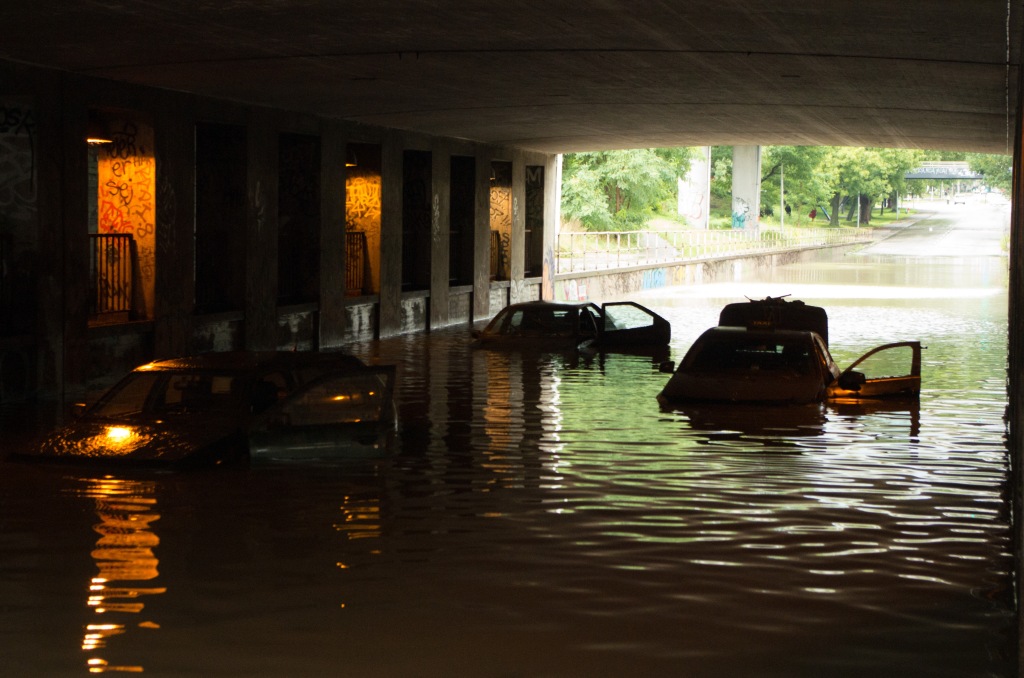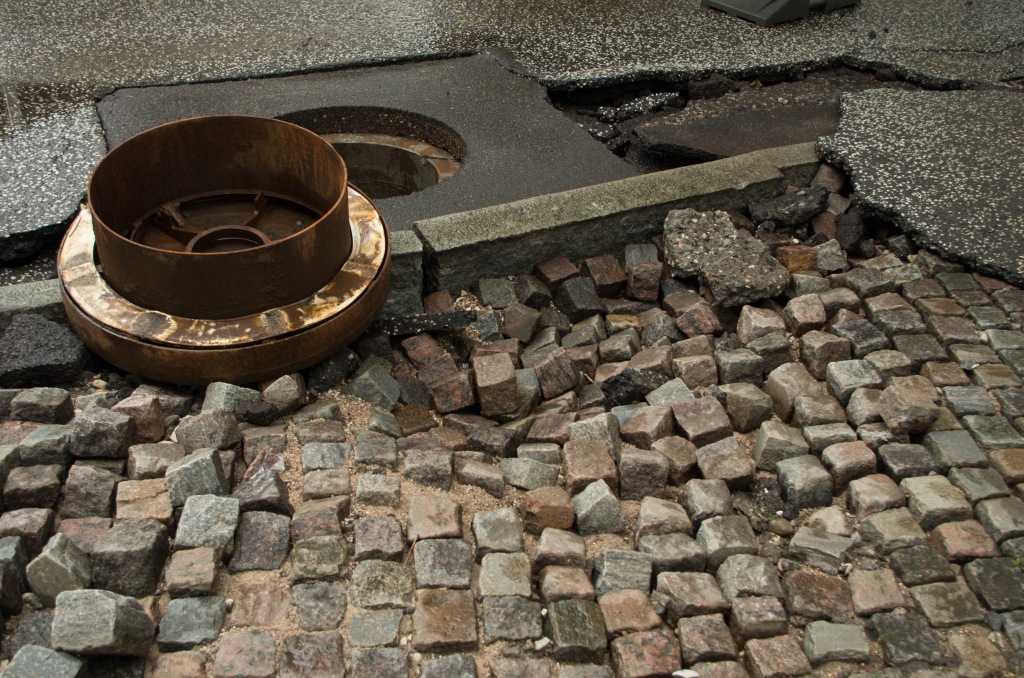By Johanna Sörensen (johanna.sorensen@tvrl.lth.se), Water Resources Engineering, Lund University
In this article, two concepts in urban storm water management, the Three Point Approach (3PA) and Sustainable Urban Drainage System (SUDS), are presented and discussed. While SUDS is well known and has been used for many years, the 3PA is new and not so well documented. SUDS could be called a Best Management Practice (BMP), while 3PA is a tool for discussing urban storm water management.
According to IPCC (2007) it is “very likely that … heavy precipitation events will become more frequent” in the future (during the 21th century) because of climate change. The expected life time of a conventional urban drainage system is 50-100 years (Winther, 2011) and consequently it is important to consider climate change effects in all urban storm management, even though the precise effect are uncertain. The uncertainty calls for a more resilient design (Godschalk, D. R., 2003).
Three point approach, 3PA
Frantini et al. (2012) have developed the Three Point Approach (3PA), which is a tool for urban flood risk management. The idea is to give managers and operators a tool for discussion and reflection when planning a new drainage system or redesigning an old system. The three points are presented as follows:
- Domain of technical optimisation: This is the domain for design storms, which are typically described by national guidelines. In this domain, system optimisation from a socioeconomic perspective is discussed. The idea of national guidelines is often to prevent cities from storm floods to occur more often than with 2-20 years return period.
- Domain of urban resilience and spatial planning: Bigger storms, with return periods higher than 2-20 years, will occur and therefore city needs to be resilient toward flood risk from such event.
- Domain of day-to-day values: When building a resilient city, as mentioned in point 2, big above ground areas are often needed. These areas should be useful also in the daily life for people in the city, which calls for an inclusion of social participation. The political and public participation is also important for the public awareness of flood risk.
Sustainable Urban Drainage System, SUDS
Urban drainage systems are built to transport waste water from households and industries to treatment plants, to drain and to prevent cities from being flooded. But, there are three major problems connected to urban drainage: pollution from Combined Sewage Overflow (CSO) and from paving, roofs, etc., high peak flows causing erosion in receiving waters and flooding when the system is overloaded. These problems calls for better design and many authors suggest Sustainable Urban Drainage System (SUDS) as a solution. Poleto (2010) presents the following goals for SUDS:
- Quantitative control of surface runoff;
- Improvement in the quality of water from surface runoff;
- Conservation of natural characteristics of bodies of water;
- Balance of hydrological variables in watersheds.
Another goal with SUDS is to achieve a more resilient urban drainage system, as the SUDS solutions are more flexible than using a conventional pipe system only.
In many cities today, we are spending a lot of money on transportation and treatment of storm water. In combined systems the storm water are often pumped a couple of times before reaching the waste water treatment plant, WWTP. The WWTPs need a huge extra capacity to be able to take care of the water load from heavy rainfall. During the rainfall, treatment processes will run in an inefficient way because of the extra load. When the limit of the WWTP and the sewage system is reached, combined sewage overflows causes pollution in the receiving waters. In separated system the storm water are often led directly to receiving waters, without any treatment. Therefore a separated system is not good enough to solve problems with heavy metals in lakes, etc. According to Berndtsson & Bengtsson (2006a, 2006b, 2007) storm water from urban areas is the highest contributor for heavy metals to smaller rivers. Therefore also storm water needs to be treated, for example in such a storm water treatment facilities as described in Vollertsen et al. (2007).
Another problem, caused by building more impermeable surfaces in the cities, is that the water cannot reach the ground water to the same extent as in natural systems. This has an effect on the water supplies where ground water is used as drinking water. In addition to this, the pollution from the cities lowers the possibility to use ground water as drinking water (Winther 2011).
Poleto (2010) suggests following types of techniques for sustainable urban drainage:
- Permeable pavement;
- Semipermeable pavement;
- Detention and retention reservoirs;
- Infiltration trenches;
- Infiltration gullies;
- Infiltration wells;
- Microreservoirs;
- Rooftop reservoirs;
- Green roofing;
- Underground reservoirs; and,
- Grassed strips.
Many of the suggested techniques above are both treating the water by sorption or degradation of pollutants and delaying the water flow and thereby minimising risk for erosion and flooding. While the permeable pavements only are effective until infiltration capacity is reached, they can be combined with other uses, like being used as a school yard or a parking lot. Infiltration trenches can successfully be combined with many other functions as they are built underground, if the hydraulic capacity of the soil is big enough. But they share one problem with conventional pipe systems; they are not flexible in their design. Green roofs are only effective for smaller rain falls, but they are useful for many other tasks, like energy saving and making solar power more efficient by lowering the temperature in cities/on the building, obtaining noise reduction, isolating buildings, providing richer ecosystems to the cities and helping degradation of air pollutants (Berndtsson 2010). Green roofs have also a big effect in lowering the annual runoff by evapotranspiration (Berndtsson 2010). Different kinds of reservoirs are very effective, but needs big areas for construction. However they can often be combined with other uses, in the same way as permeable areas. Grass areas in parks can be used as storm water reservoir while raining and as a recreational area in sunny days.
One SUDS technique not mentioned in the list above from Poleto (2010) is the synthetic wetlands used for instance in Malmö, Sweden (Stahre, 2006). This technique is very effective, both for flood control, detention and remediation, if the required area are present.
Discussion
We are facing a climate change, which means that we can expect more extreme weather, including more extreme rain fall. The investments for adaption to more heavy rainfalls are huge. As we would like to develop our cities to more liveable places, we need to cleverly use every penny two times: both for storm water control and for other things such as for recreation, better ecosystems in our cities, energy saving and so on. The Three Point Approach helps us to discuss the different needs in a systematic and holistic way.
One thing that Frantini et al. (2012) do not mention is the importance of taking care of pollution from storm water and sewage system. The focus in Frantini et al. (2012) is on flood risk. I suggest that the third point, day-by-day values, in an extended version of the 3PA also should include also the pollution problem. By discussing pollution as a part of the day-to-day values domain, a more sustainable system would probably be built. A slow runoff is important for both degradation of pollutants and a more controlled outflow to receiving waters. In a combined system a slow runoff would secure better remediation at the treatment plant and fewer sewage overflows.
I have tried to find literature on two other subjects of interest, by searching in online libraries and talking to professors and practitioners in urban storm water planning. I have found little concerning the following questions and I would therefore suggest further research in these areas:
- Catchment effects from SUDS – how is the downstream system effected by implementation of Sustainable Urban Drainage System in one part of the city? Is it needed to reconstruct the drainage system of the whole city to have a well functioning system, meeting climate change in the future? Or is it enough to reconstruct and develop SUDS in only some parts of the city?
- SUDS effect on extreme events – can SUDS protect against flooding from extreme events (point 2 in the three point approach)? Or is a conventional pipe system with large basins needed in addition?
Note that this text was written in December 2012. For instance, I have published a paper on how SUDS affect flooding during extreme events. However, I still find it relevant and hereby publish the text for anyone to read.
References
Berndtsson, J. C. & Bengtsson, L. (2006a) Vattenöversikt i tre skånska åar, VA-forsk rapport nr 2006-22
Berndtsson, J. C. & Bengtsson, L. (2006b) Stadens inverkan på vattenmiljön i avrinningsområden, VA-forsk rapport nr 2006-23
Berndtsson, J. C. & Bengtsson, L. (2007) Vattenöversikt i små avrinningsområden i Skåne, VATTEN-3-07
Berndtsson, J. C. (2010) Green roof performance towards management of runoff water quantity and quality: A review, Ecological Engineering, Volume 36, Issue 4, April 2010, Pages 351–360
IPCC (2007) Climate Change 2007: Synthesis Report: An Assessment of the Intergovernmental Panel on Climate Change
Frantini et al. (2012) Three points approach (3PA) for urban flood risk management: A tool to support climate change adaptation through transdisciplinary and multifunctionality, Urban Water Journal 2012, 1-15
Stahre, P. (2006) Sustainable in urban storm drainage, Svenskt Vatten, ISBN 91-85159-20-4
Vollertsen et al. (2007) Treatment of urban and highway stormwater runoff for dissolved and colloidal pollutants, conference paper, Novatech’2007
Winther L. et al. (2011) Afløbsteknik 6. udgave, Polyteknisk Forlag, ISBN 978-87-502-1015-3
Godschalk, D. R., (2003) Urban Hazard Mitigation: Creating Resilient Cities, Nat. Hazards Rev. 2003.4:136-143


























